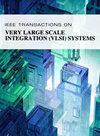iEDCL:在支持近阈值的 32 位处理器中简化的无误差检测和纠错方案
IF 2.8
2区 工程技术
Q2 COMPUTER SCIENCE, HARDWARE & ARCHITECTURE
IEEE Transactions on Very Large Scale Integration (VLSI) Systems
Pub Date : 2024-06-17
DOI:10.1109/TVLSI.2024.3409315
引用次数: 0
摘要
本文介绍了内部错误检测、纠正和锁存 (iEDCL),这是一种对设计人员友好的全功能错误检测和纠正 (EDAC) 方法,专为能够容许变化的高能效近阈值系统量身定制。它将错误检测 (ED)、纠正和锁存电路嵌入一个触发器 (FF),并增加了 15 个晶体管来监控关键路径。值得注意的是,尽管存在时钟延迟和寄生效应,iEDCL 的错误感知能力仍能保持稳定,从而减轻了设计人员的大量工作,并消除了错误。iEDCL 在 ARM Cortex-M0 处理器中以 55 纳米工艺自动实现,无需额外的架构修改,仅产生 6.78% 的面积开销。自适应电压缩放(AVS)环路实现了自动运行,在保持预定误差率的同时,实现了首次故障点之后的高能效。在不同温度下从不同芯片获得的测量结果表明,iEDCL 处理器实现了显著的节能效果,与临界基线和签名设计相比,分别降低了 16.9% 和 49.1%,同时在 16 MHz 频率下保持了 5% 的错误率。据我们所知,这篇文章介绍了首批 FF EDAC 实现之一,在提高能效的同时,在近阈值电压下没有潜在的误差。本文章由计算机程序翻译,如有差异,请以英文原文为准。
iEDCL: Streamlined, False-Error-Free Error Detection and Correction Scheme in a Near-Threshold Enabled 32-bit Processor
This article presents internal error detection, correction, and latching (iEDCL), a designer-friendly, fully functional error detection and correction (EDAC) approach tailored for energy-efficient near-threshold systems capable of tolerating variations. It embeds error detection (ED), correction, and latching circuits within a flip-flop (FF) with an additional 15 transistors to monitor critical paths. Notably, iEDCL’s error-aware capability remains stable despite clock latency and parasitic effects, relieving designers of extensive involvement and eliminating false errors. iEDCL is automatedly implemented in an ARM Cortex-M0 processor at 55 nm without extra architecture modifications, incurring only a 6.78% area overhead. An adaptive voltage scaling (AVS) loop enables automatic operation, achieving high energy efficiency beyond the point of the first failure while maintaining a predefined error rate. Measurement results obtained from different dies at various temperatures demonstrate significant energy savings achieved by the iEDCL processor, with up to 16.9% and 49.1% reductions compared to critical baseline and signoff designs, respectively, while maintaining a 5% error rate at a 16 MHz frequency. To the best of our knowledge, this article presents one of the first FF EDAC implementations fully operational without potential false errors at near-threshold voltages while enhancing energy efficiency.
求助全文
通过发布文献求助,成功后即可免费获取论文全文。
去求助
来源期刊
CiteScore
6.40
自引率
7.10%
发文量
187
审稿时长
3.6 months
期刊介绍:
The IEEE Transactions on VLSI Systems is published as a monthly journal under the co-sponsorship of the IEEE Circuits and Systems Society, the IEEE Computer Society, and the IEEE Solid-State Circuits Society.
Design and realization of microelectronic systems using VLSI/ULSI technologies require close collaboration among scientists and engineers in the fields of systems architecture, logic and circuit design, chips and wafer fabrication, packaging, testing and systems applications. Generation of specifications, design and verification must be performed at all abstraction levels, including the system, register-transfer, logic, circuit, transistor and process levels.
To address this critical area through a common forum, the IEEE Transactions on VLSI Systems have been founded. The editorial board, consisting of international experts, invites original papers which emphasize and merit the novel systems integration aspects of microelectronic systems including interactions among systems design and partitioning, logic and memory design, digital and analog circuit design, layout synthesis, CAD tools, chips and wafer fabrication, testing and packaging, and systems level qualification. Thus, the coverage of these Transactions will focus on VLSI/ULSI microelectronic systems integration.

 求助内容:
求助内容: 应助结果提醒方式:
应助结果提醒方式:


